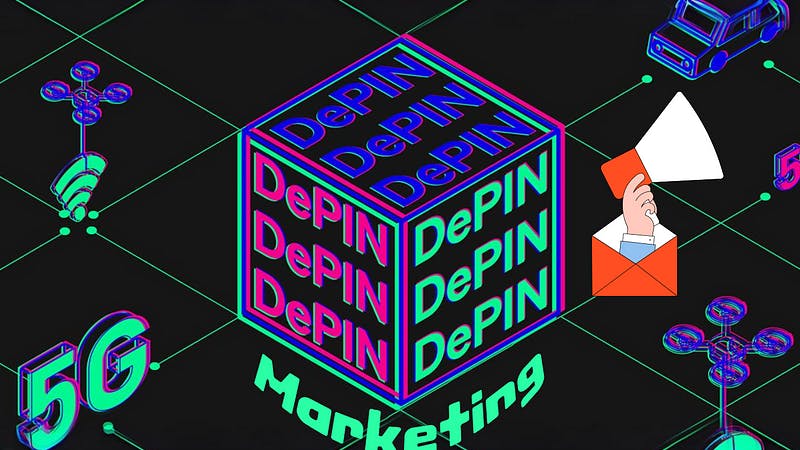Ever seen a mission impossible movie? Or maybe you’re a bigger nerd than me and you’ve read the books. It always begins with the incredibly exciting introduction that I have edited below;
Good morning, [Mr. Hero]. Your mission, should you decide to accept it, is to [insert ridiculously difficult mission here]. As always, should you or any member of your IM Force be caught or killed, the secretary will disavow any knowledge of your actions. This tape/disc will self-destruct in five/ten seconds. Good luck, [Hero].
Then if you are a movie guy like me, the jingly tune plays and Tom Cruise (Ethan Hunt) enters to do a lot of exciting stunts that will make the news even in real life. But he will accomplish the “impossible” mission though. Whether it’s a ghost AI, or a secret cult of world leaders, Ethan Hunt would eventually overcome the supposedly invincible, world ending threat, making the entire movie a paradox. Shout out to Hollywood.

Well, if you are such a big fan like me, at some point during the utopic movie experience you may have wished you were Ethan Hunt saving the world, however thanklessly. Rejoice now, because I’m about to take you on an exciting journey to unravel a mysterious, relatively new technology that is revolutionizing the entire internet and rescue you (an anyone you share this piece with) from the sneaky, evil ignorance preventing you from enjoying the myriad gifts of the technology.
DePIN Recon!
The current internet is known as Web 2. It is a version of the internet dominated by centralized companies running dynamic websites and applications that enable user interaction. However glorious Web 2 has come to be, though, it suffers from one fatal flaw: centralization. Web 2 companies are centrally owned and managed. This means that an entire technology serving billions of people is completely subject to the agenda of a handful of corporations and personal interests. The worst is yet to come.
So IT(information technology) runs on infrastructure, right? I mean the servers, masts, giant cables, satellites, etc. that power what we call the internet. Imagine how much that costs. Definitely too much for the regular Joe on the street. Well, very few people can actually afford to set up this infrastructure, hence, the industry is already monopolized by money. This is beside the fact, though, the main issue is how vulnerable this centralized infrastructure makes the entire system. A single problem in the server, wiring, or software can bring down the entire system. Hence, all that work to make the world a global village can be undone with one single breach. Summarily, our current internet has a fragile backbone.
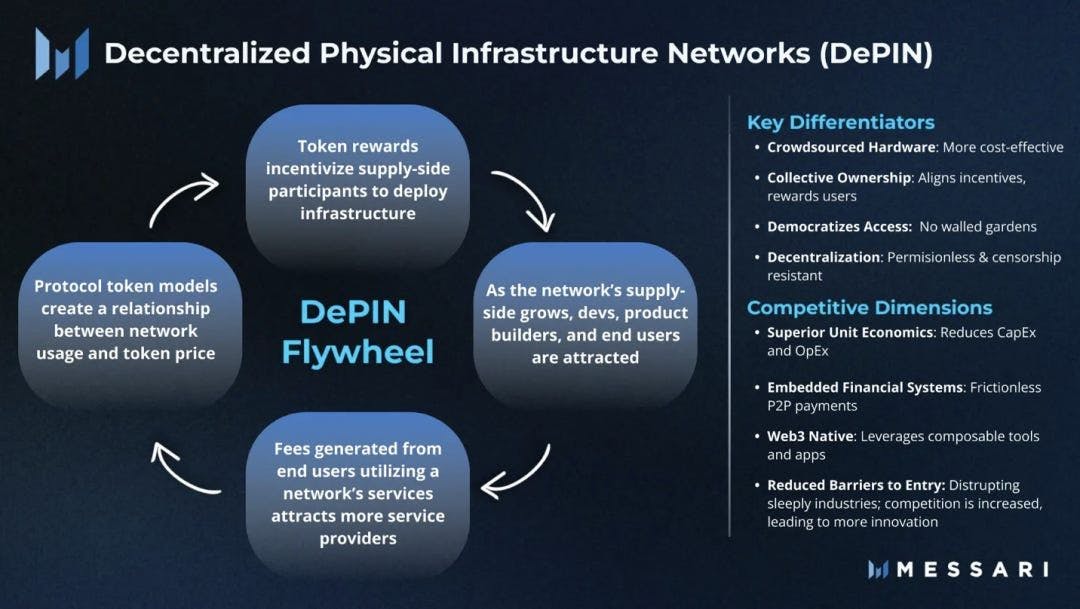
DePIN is a concept that uses token rewards to encourage establishing and developing physical infrastructure in the real world. Physical infrastructure includes wireless networks, cloud services, mobility networks, and power grids. Most of them have been dominated by large companies with high capital. Centralized entities almost monopolize the prices and services offered to end users, leading to a lack of competition and innovation. The DePIN project seeks to solve some of these problems by utilizing blockchain technology, token incentives, and the power of the internet. A key feature of DePIN is the shift from the traditional centralized model to a decentralized one. It involves global user participation to overcome dependency on large entities and implement a ‘sharing economy’ model.
As the name suggests, DePIN (Decentralized Physical Infrastructure Network) merges decentralized technology with physical infrastructure, creating new opportunities for efficiency, security, and global accessibility. DePIN, or Decentralized Physical Infrastructure Networks, is a concept where blockchain technology is applied to manage and operate physical infrastructure. Unlike traditional infrastructure systems, controlled by governments or private entities, DePIN uses decentralized networks to distribute control among participants.
For example, rather than a telecom provider owning a network of cell towers, a DePIN project could allow individual operators to host nodes that form a collective network. This approach enhances inclusivity and minimizes single points of failure. The magic of DePIN lies in its integration of blockchain’s decentralized nature with tangible infrastructure.
Why DePIN?
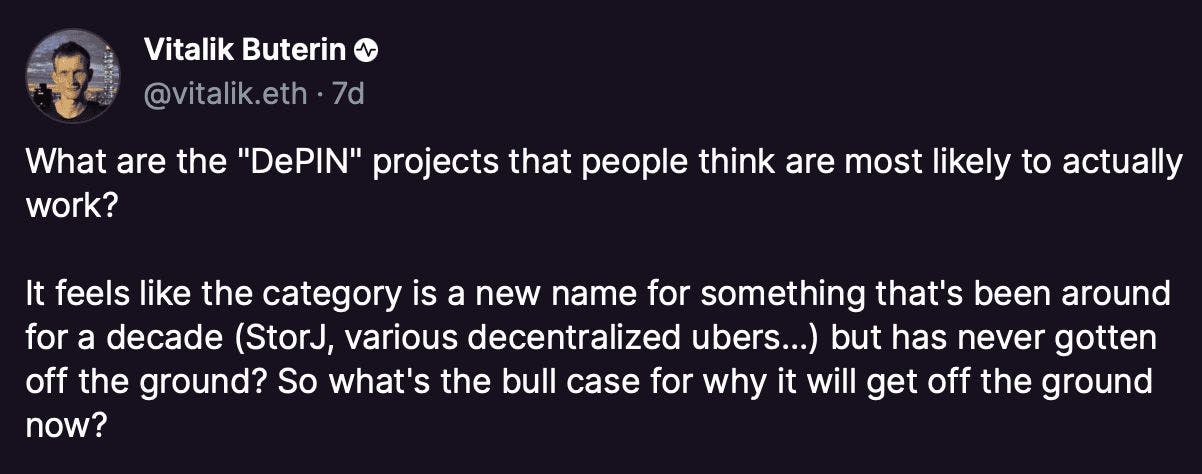
While we’ve thoroughly examined the security challenges posed by traditional centralized systems, another significant limitation that deserves attention is their scalability and global reach. In today’s information-driven era, the world is often described as a “global village,” implying seamless connectivity and access to information regardless of location. However, this vision is far from realized due to the inherent infrastructure challenges in centralized Web2 models.
Traditional internet infrastructure relies heavily on expensive physical components like network masts, fiber optic cables, and centralized data centers. These costs make it economically unfeasible to extend reliable internet services to remote, rural, or underserved regions. As a result, millions of people remain digitally disconnected, limiting their access to essential services, education, financial systems, and opportunities that thrive online. This imbalance in global connectivity undermines the inclusive potential of the internet and exacerbates the digital divide.
This is precisely where Decentralized Physical Infrastructure Networks (DePIN) can present a transformative solution. Unlike traditional centralized systems, DePIN leverages distributed networks powered by individual participants rather than a single, controlling entity. By using blockchain-based nodes that are independently operated, DePIN enables a more democratic and cost-effective approach to building physical infrastructure.
Imagine deploying small, locally run blockchain nodes in communities that lack conventional internet infrastructure. These nodes could function as mini-hubs, connecting users in the area and interfacing with the broader internet. Not only does this approach reduce the reliance on costly large-scale hardware installations, but it also empowers local populations to take control of their digital connectivity.
Such an implementation of DePIN would not only enhance reach and scalability but also increase resilience, as these networks are less prone to single points of failure. More importantly, this model fosters a participatory ecosystem where individuals contribute to and benefit from the network, driving both technological and socioeconomic development.
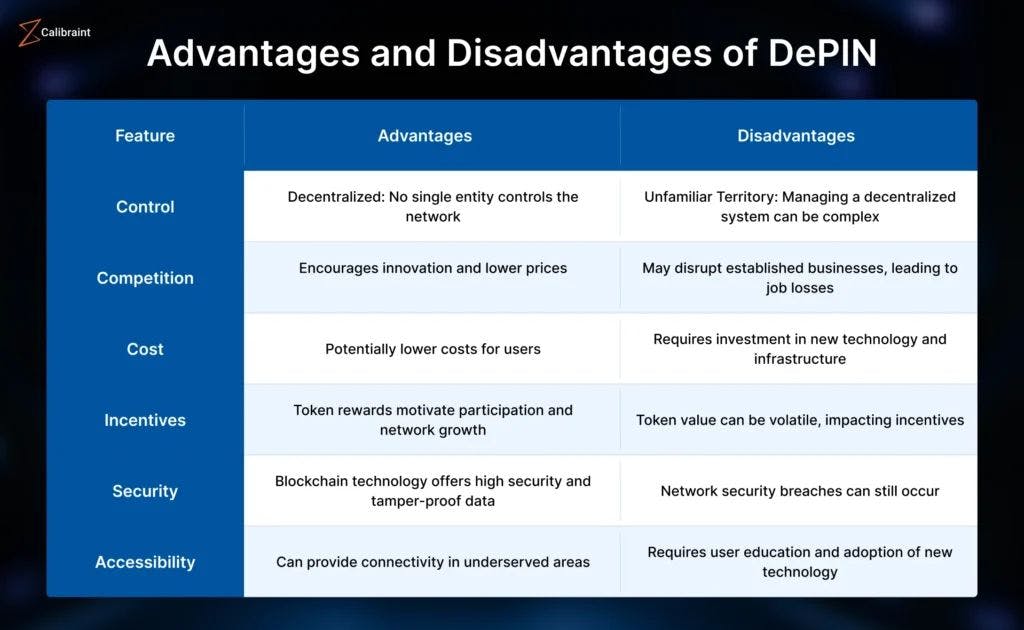
In essence, by reimagining infrastructure through decentralized frameworks, DePIN has the potential to bridge the connectivity gap that centralized systems have long struggled to address. It offers a path toward a more truly global internet—one that is inclusive, resilient, and aligned with the principles of decentralization and community empowerment.
In Summary:
- Security: DePIN technology in general creates a more secure system by tackling the singular point of failure problem found in centralized infrastructure.
- Cost: DePIN technology (blockchain nodes) is cheaper to set up and maintain than centralized infrastructure (satellites, masts, cables, and servers).
- Scalability: DePIN infrastructure is easier to set up in any part of the world, and hence is more scalable than centralized infrastructure.
DePIN models by project
Though a single ideology, various models of DePIN have emerged based on the architecture of different projects that use the technology. We shall be exploring these models below;
-
User-as-a-node Model:
This a DePIN model where the individual devices connecting to a decentralized network constitute the nodes of the network. This is the most decentralized model possible and offers the best individual utility to all users of the network. The entire network infrastructure is fairly distributed among the users of the network who are usually rewarded with network tokens for participating on the network.
Advantages:
- Complete decentralization of network infrastructure
- Total democracy in network operation
- Evenly distributed profit system
Disadvantages:
- Slow decision making
- Abuse of voting rights by users
Example:
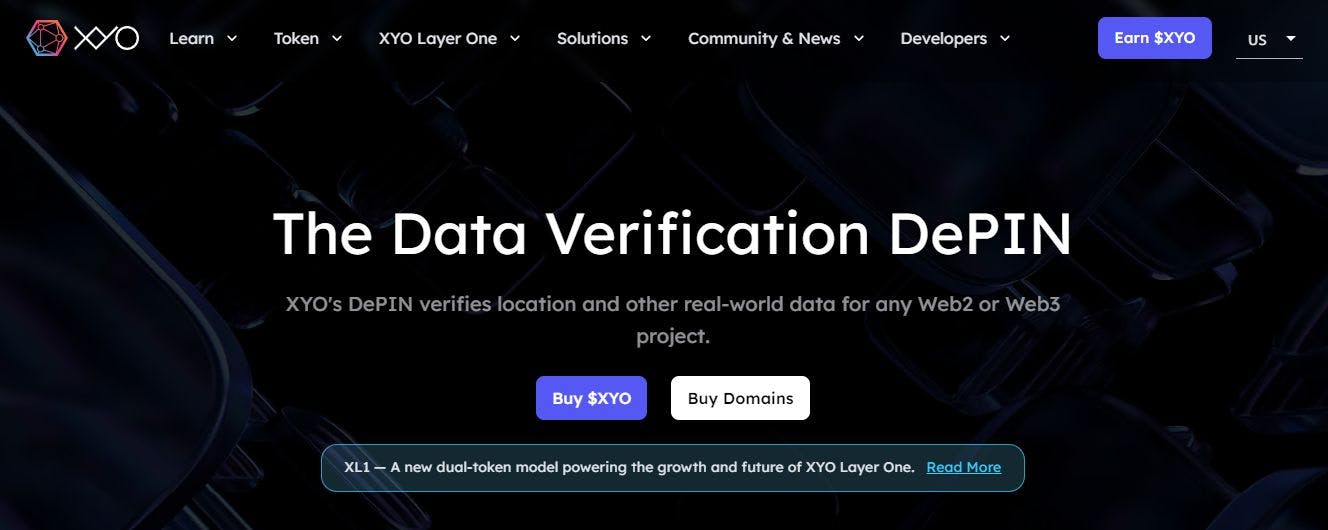
XYO is a blockchain-based technology that allows any device or person to participate in DePIN anywhere, securely and effortlessly through data contributions. It operates as a trustless oracle, providing Web2 and Web3 clients with easy access to reliable and accurate real-world and digital data. By utilizing its decentralized network, XYO ensures the integrity and security of data, making it a critical tool for building trustless applications across industries.
In 2025, XYO expanded with XYO Layer One, a custom blockchain optimized for large-scale data and decentralized applications, such as AI, DePIN, RWA tracking, and gaming. XYO Layer One introduces scalable data infrastructure without blockchain bloat — solving the core problem of traditional blockchains struggling to handle user-contributed data at scale.
This innovation led to the launch of the COIN app in early 2019, a groundbreaking platform that rewards users for generating data. With over 10 million installs across more than 150 countries, COIN has paid out over $10 million USD in rewards to its users, who have collectively earned more than 5 billion XYO Tokens. Some of these tokens have even appreciated enough in value to cover significant, real-life expenses.
-
Middle-node Model:
This is a decentralized architecture where the nodes of the network act as middle men between the end users and the network software. Anyone can setup a node of course but it usually requires more technical know how to operate and is often more expensive to run than the first model.
Advantages:
- Node management is democratized
- Less abuse of voting rights due to required expertise and cost to operate a node
- Faster decision making
Disadvantages:
- More like an oligarchy than a democracy
- Cost of owning a piece of the infrastructure is considerable
Example:

Spacecoin is the world’s first decentralized physical infrastructure network (DePIN) powered by blockchain-enabled LEO nanosatellite constellations, positioned to become the standard open protocol for trustless internet connectivity on a global scale – connecting everyone and everything. By using a constellation of small LEO satellites to create a global 5G network, this physical decentralization eliminates reliance on central authorities, reducing censorship risks and service outages while ensuring coverage in remote areas.
Blockchain technology powers Spacecoin’s decentralized network, enabling transparent satellite operations with smart contracts. It manages data transmissions securely on-chain, ensuring a trustless, scalable, and resilient system without a central authority. By enabling a blockchain-native system that allows users to pay network fees with cryptocurrency, it removes financial and country borders, even in regions with limited banking infrastructure.
Unbanked users can build their on-chain credit profiles simply by using and paying for Spacecoin’s internet. By building their credit profile, it opens up greater financial accessibility and opportunity.
- Combination Model:
As the name suggests this model allows the in combination of two or more models to achieve a more robust network architecture. For example, centralized infrastructure could be combined with blockchain technology to form a hybrid network. This model combines the strengths of different network models and compensates their individual limitations. It has been given a new acronym i.e., CEDEPIN.
Advantages:
- Robust architecture suited to any use case
- Easy support for web2 companies to join the web 3 space while maintaining their legacy infrastructure
- Democratized network ownership but well regulated by the central institution
Disadvantages:
- Limited decentralization
- High cost of combined web 2 and web 3 infrastructure
Example:
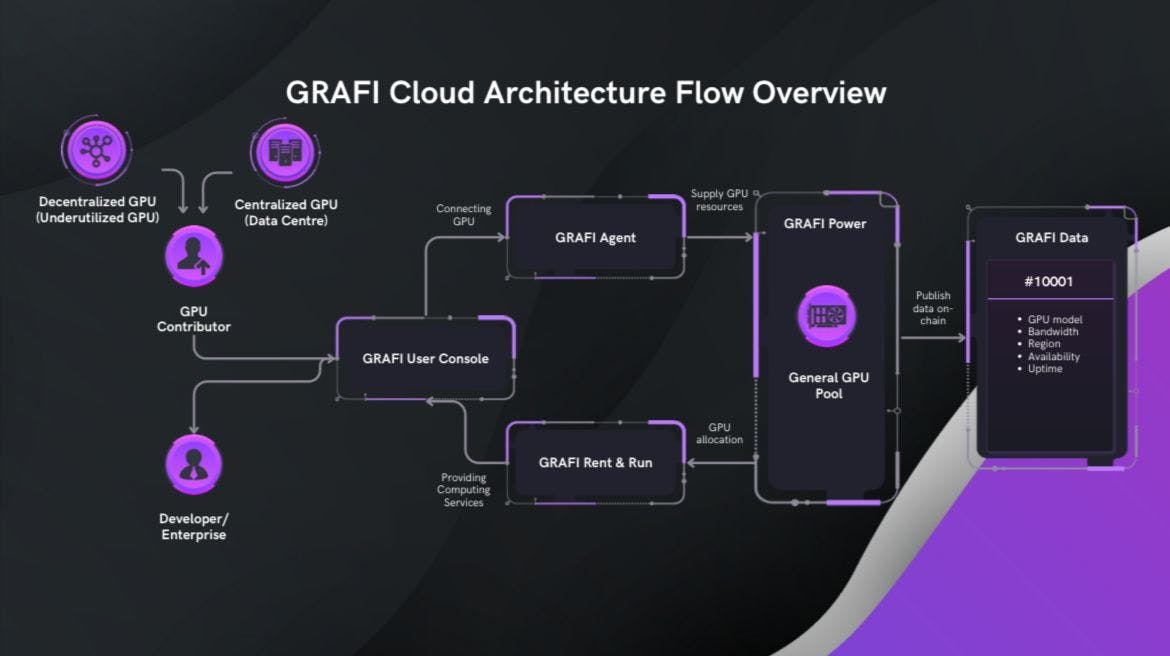
Grafilab is a revolutionary company reshaping the future of computing power in the AI-driven era of Industry 5.0. By recognizing computing power as the “digital oil” of this new age, Grafilab is democratizing access to high-performance computational resources, enabling everyday individuals to participate in and benefit from the AI revolution. Through its innovative CeDePIN structure, Grafilab allows users to own fractions of GPUs and rent out their computing power, contributing to a decentralized network that fuels AI advancements. With a focus on inclusivity, Grafilab’s partnerships with global data centers and educational institutions further solidify its mission to bridge the gap between AI technology and widespread accessibility, driving the path from AI to AGI for all.
Grafilab is building a decentralized AI ecosystem that empowers ordinary people to participate in AI development, deployment and commercialization. By offering tools like the CeDePIN Cloud, Co-Builder platform and App Store, all secured through our AI Data Layer, Grafilab enables users and developers to access, build, and monetize AI without deep technical expertise.
Which model do I need
The model to use depends on a number of factors like what kind of project you’re building (e.g., web 3 cloud, web 3 exchange or web 3 games), who you’re building for (e.g., enterprise or end users), and how much you’ve got to invest.
- User-as-a-node model is best suited to user facing applications like web 3 games and utility software which are cheap and easy to run.
- Middle-node model is best suited to enterprise software were the web 3 enterprises using the software can afford to setup and operate the nodes.
- Combined model is best suited to more expensive, enterprise software requiring bigger companies to form the central layer.
Conclusion
Good day, our Hero. You’ve done a good recon of DePIN technology. Your mission, should you decide to accept it, is to join this revolution by building with the technologies outlined or by sharing this piece to spread the word.

I kid of course.
Good luck, Hero.
